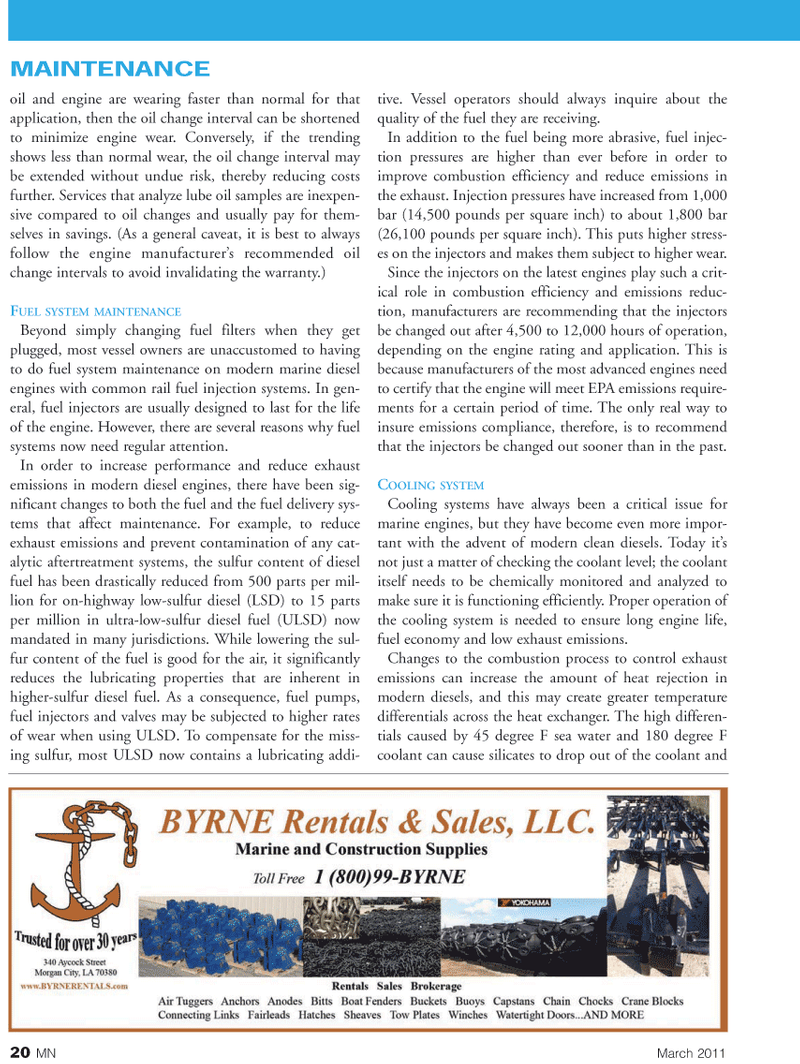
Page 20: of Marine News Magazine (March 2011)
Marine Training & Education Edition
Read this page in Pdf, Flash or Html5 edition of March 2011 Marine News Magazine
20 MN March 2011
MAINTENANCE oil and engine are wearing faster than normal for that application, then the oil change interval can be shortened to minimize engine wear. Conversely, if the trending shows less than normal wear, the oil change interval may be extended without undue risk, thereby reducing costs further. Services that analyze lube oil samples are inexpen- sive compared to oil changes and usually pay for them- selves in savings. (As a general caveat, it is best to always follow the engine manufacturer’s recommended oil change intervals to avoid invalidating the warranty.)
FUEL SYSTEM MAINTENANCE
Beyond simply changing fuel filters when they get plugged, most vessel owners are unaccustomed to having to do fuel system maintenance on modern marine diesel engines with common rail fuel injection systems. In gen- eral, fuel injectors are usually designed to last for the life of the engine. However, there are several reasons why fuel systems now need regular attention.
In order to increase performance and reduce exhaust emissions in modern diesel engines, there have been sig- nificant changes to both the fuel and the fuel delivery sys- tems that affect maintenance. For example, to reduce exhaust emissions and prevent contamination of any cat- alytic aftertreatment systems, the sulfur content of diesel fuel has been drastically reduced from 500 parts per mil- lion for on-highway low-sulfur diesel (LSD) to 15 parts per million in ultra-low-sulfur diesel fuel (ULSD) now mandated in many jurisdictions. While lowering the sul- fur content of the fuel is good for the air, it significantly reduces the lubricating properties that are inherent in higher-sulfur diesel fuel. As a consequence, fuel pumps, fuel injectors and valves may be subjected to higher rates of wear when using ULSD. To compensate for the miss- ing sulfur, most ULSD now contains a lubricating addi- tive. Vessel operators should always inquire about the quality of the fuel they are receiving.
In addition to the fuel being more abrasive, fuel injec- tion pressures are higher than ever before in order to improve combustion efficiency and reduce emissions in the exhaust. Injection pressures have increased from 1,000 bar (14,500 pounds per square inch) to about 1,800 bar (26,100 pounds per square inch). This puts higher stress- es on the injectors and makes them subject to higher wear.
Since the injectors on the latest engines play such a crit- ical role in combustion efficiency and emissions reduc- tion, manufacturers are recommending that the injectors be changed out after 4,500 to 12,000 hours of operation, depending on the engine rating and application. This is because manufacturers of the most advanced engines need to certify that the engine will meet EPA emissions require- ments for a certain period of time. The only real way to insure emissions compliance, therefore, is to recommend that the injectors be changed out sooner than in the past.
COOLING SYSTEM
Cooling systems have always been a critical issue for marine engines, but they have become even more impor- tant with the advent of modern clean diesels. Today it’s not just a matter of checking the coolant level; the coolant itself needs to be chemically monitored and analyzed to make sure it is functioning efficiently. Proper operation of the cooling system is needed to ensure long engine life, fuel economy and low exhaust emissions.
Changes to the combustion process to control exhaust emissions can increase the amount of heat rejection in modern diesels, and this may create greater temperature differentials across the heat exchanger. The high differen- tials caused by 45 degree F sea water and 180 degree F coolant can cause silicates to drop out of the coolant and

 19
19

 21
21
